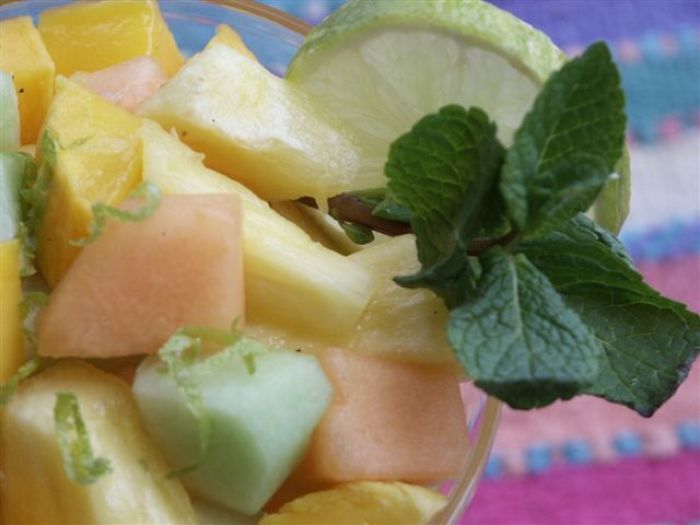
Click on the pix above to get a larger view and read the captions.
Mints come in such a profusion of varieties–and all tend to crossbreed with each other–leading to much confusion among both the marketers and buyers of mints; even herbal experts do not always describe the same species in the same way. To make sure that you are buying plants that are closest to the true species, buy them from a trusted herb grower.
Mentha spp.
Peppermint Mentha xpiperita ‘Mitcham’
Spearmint Mentha spicata
Orange mint Mentha aquatica
Native Habitat: Europe
Plant Type: Perennial, zone 4 to 9
Introduction
The mint family is a lively group; not only is it prolific in numbers and growing habits, but it has many forms, not to mention flavors. All of the mints have square, branching stems and contain volatile oils which make them very aromatic. The menthol which gives mints their well-known scent and flavor is used for culinary, medicinal, and commercial purposes. Mint is effective as a digestive aid with its stomach-soothing properties, and helps relieve flatulence, as well as being a stimulant. It is used in many commercial preparations such as toothpaste, chewing gum, mouthwash, liniments, cold remedies, and medicines.
How to Grow
Mints cultivated from seed are notoriously variable. Some, such as peppermint¾a sterile hybrid of M. aquatica and M. spicata¾ can’t be grown from seed at all. So the best quality mints come from cuttings. Plant different varieties of mint away from one another—at least a couple of yards if possible so they don’t cross pollinate. In small gardens, confine mints in tubs or pots, either buried in beds or left to stand as container plants, as mints propagate through runners and have a tendency to take over the whole garden. Water, good drainage, and a well-fertilized soil are their only growing requirements. They prefer sun in most climates, but will grow in partial shade, and thrive there in very hot climates. Snip your mints freely throughout the season.
Harvesting the Mints
Cut back larger plantings for dried herbs at least three times during the season, and harvest in fall just before flowering or when the lower leaves yellow, whichever comes first. You can cut the plants back to the ground at this time. Hang large harvests in bunches upside down in a shady, dry, and warm place. You can dry small amounts, by stripping the leaves from the stems and drying them on a screen under the same conditions as above.
Some Varieties
Although there are many mints available, here are some handsome and tasty varieties of the Labiatae family, Mentha sp., that are easy to procure at herb nurseries throughout the U. S.
Applemint Mentha suaveolens–The mild flavor of this fuzzy-leaved mint, which comes in green or variegated types, has a very slight apple-like aroma, it is good with fruit salads, in beverages, or as a garnish.
Chocolate Mint Mentha xpiperita–This mint is so close in chemistry to Mitcham or Blue Balsam peppermint that it really doesn’t deserve to be listed under its own classification. It has an appearance and taste like that of the aforementioned, but it works well with chocolate—in cookies, cakes, brownies, and ice cream.
Curly Mint Mentha spicata ‘Crispa’–This subtle spearmint has bright, deep-green crinkled leaves and adds a sprightly look wherever it chooses to pop up in the garden. It is one of my favorites in beverages like mojitos and mint juleps.
Ginger Mint Mentha xgracilis ‘Variegata’–A pretty, smooth-leaved mint that is bright green splashed with gold; it has a mild ginger flavor with a hint of fruit.
Kentucky Colonel Mentha spicata ‘Kentucky Colonel’–This mild-mannered, tasty spearmint is the one to put in a mint julep or any other summertime beverage.
Orange Mint Mentha aquatica; formerly called M. Citrata–Also referred to as lemon or bergamot mint, this green, smooth-leaved variety has a strong citrus scent and taste, similar to that of the bergamot oil that is used in Earl Grey tea.
Pennyroyal Mentha pulegium sp.–Upright or creeping, this herb has a peppermint-like aroma, but it is not good for culinary use. It is a nice specimen for the herb garden and is a useful insect repellent.
Peppermint Mentha xpiperita sp.–There are many varieties of peppermint with all of them having a strong mint fragrance and peppery taste; they have the highest amounts of menthol . Use them in dishes or drinks where a strong mint flavor is desired.
Spearmint Mentha spicata sp.–This species is milder and sweeter than the peppermints and is good used in beverages, jellies and jams, and desserts.
Yerba Buena Mentha cordifolia–The pale green leaves of this mint are found in Latin America, Mexico, and the Southwestern U.S. where it is used in regional dishes from tea, soups, stews, and desserts.
For a lovely mint recipe try my tropical fruit salad with vanilla mint syrup
excerpted from not just desserts–sweet herbal recipes published by herbspirit in 2005, available at www.susanbelsinger.com.




















Comments
Log in or create an account to post a comment.
Sign up Log in